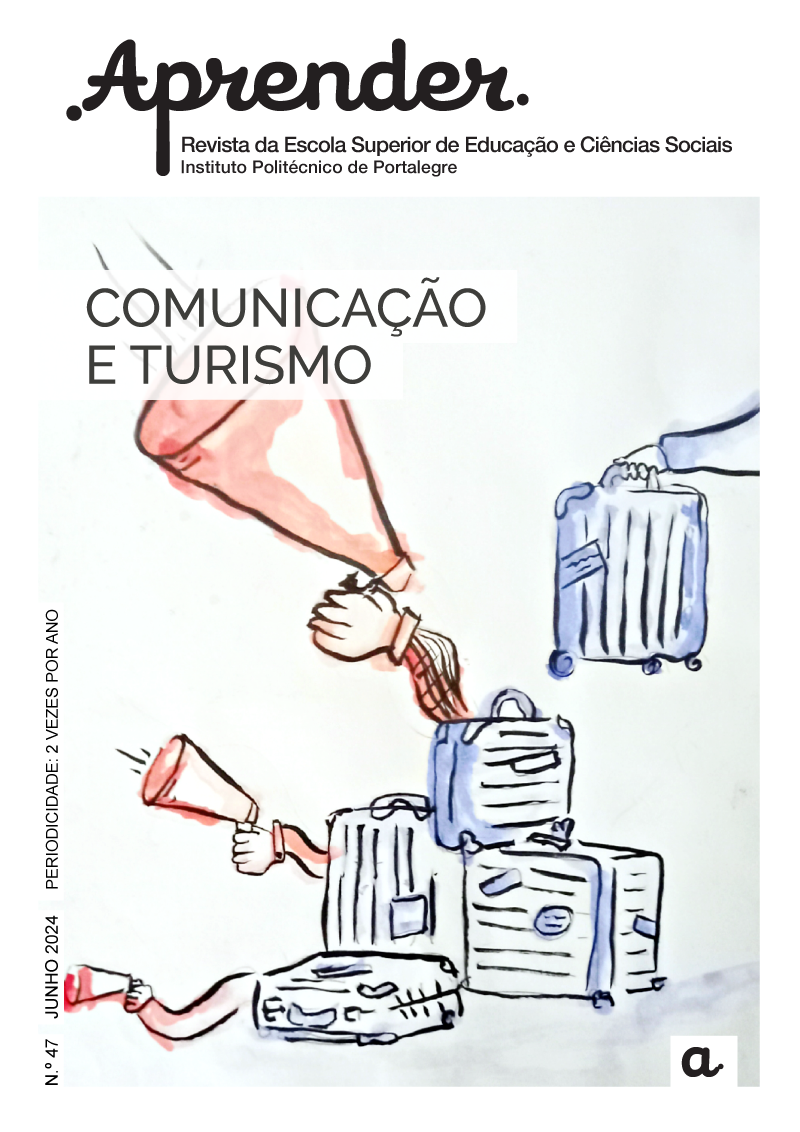Virtual Alentejo
Analysis and reflection on a 360º virtual tour
DOI:
https://doi.org/10.58041/aprender.211Keywords:
360º virtual tour, audiovisual language, narrative, tourism, virtual realityAbstract
Tourism is increasingly making use of digital technologies, including Virtual Reality, to promote its offer, seeking to adapt to current society trends. Following this logic, Turismo do Alentejo created an online portal, Visit Alentejo, which provides a 360º virtual visit to multiple tourist sites in the region. The goal of this work is to understand to what extent this virtual visit capitalizes on the potential of technology and audiovisual language to achieve maximum communicative and effective potential in promoting Alentejo as a tourist destination. In this sense, a corpus of specific visits was selected and qualitatively analyzed, at the level of content (type of information offered), form (media formats used and their formal and stylistic features) and the interaction the visit allows the user. We then discuss the results in light of the theoretical framework presented, in the convergence of tourism, virtual reality and media studies, and reflect upon the potential virtues and limitations of the virtual visit, offering suggestions to make it more appealing. The main suggestion concerns the creation of additional narrative content, in audio and video format, that allows “populating” the virtual environment and illustrating the identity and authenticity of the Alentejo people and territory.
References
Adachi, R., Cramer, E. M., & Song, H. (2022). Using virtual reality for tourism marketing: A mediating role of self-presence. The Social Science Journal, 59(4), 657-670. https://doi.org/10.1080/03623319.2020.1727245
Aumont, J. & Marie, M. (2009). A Análise do Filme. Texto & Grafia.
Eliseu, S., Sousa, M. N. Berlinde, A., & Bogdan, M., (2022). Virtual Tourism as a Pedagogical Practice - Adaptation of curricular content during and after a Pandemic. In P. Andrade, & M. L. Martins (Eds.), Handbook of Research on Urban Tourism, Viral Society, and the Impact of the COVID-19 Pandemic (pp. 497-516). IGI Global. https://doi.org/10.4018/978-1-6684-3369-0
Conceição, R., & Netto, A. (2022). A importância da presença para a hospitalidade virtual. Revista Hospitalidade, 19, 111-132. https://www.revhosp.org/hospitalidade/article/view/1001
EY Parthenon. (2020). Estratégia Regional de Desenvolvimento Turístico do Alentejo e Ribatejo 2021-27. Relatório Final. https://www.visitalentejo.pt/fotos/editor2/pdfs/Documentos_Estrategicos/ERT_Alentejo_Relatorio_Final_122020.pdf
Gonçalves, D., Fonseca, M., & Campos, P. (2017). Introdução ao design de interfaces. FCA.
Gutiérrez, M., Vexo, F., & Thalmann, D. (2008). Stepping into Virtual Reality. Springer.
Guttentag, D. (2010). Virtual reality. Applications and implications for tourism. Tourism Management, 31, 637-651. https://doi.org/10.1016/j.tourman.2009.07.003
Huang, Y., Backman, K., Backman, S., & Chang, L. L. (2016). Exploring the Implications of Virtual Reality Technology in Tourism Marketing: An Integrated Research Framework. International Journal of Tourism Research, 18, 116-128. https://doi.org/10.1002/jtr.2038
Lo, W. H., & Cheng, K. L. (2020). Does virtual reality attract visitors? The mediating effect of presence on consumer response in virtual reality tourism advertising. Information Technology & Tourism, 22, 537–562. https://doi.org/10.1007/s40558-020-00190-2
Lopes, C., & Rengifo-Gallego, J. I. (2023). El enoturismo en Internet. Evaluación de los sitios web de las bodegas de tres rutas del vino de Extremadura (España) y de Alentejo y Região Centro (Portugal). Investigaciones Turísticas, 26, 207-234. https://doi.org/10.14198/INTURI.21870
McQuail, D. (2003). Teoria da Comunicação de Massas. Fundação Calouste Gulbenkian.
Navarro, D. S. (2013). Entorno virtual y turismo: interacción simbólica. Revista Iberoamericana de Turismo, 3(2), 17-24. https://www.seer.ufal.br/index.php/ritur/article/view/1028/811
Quivy, R., & Campenhoudt, L. V. (2008). Manual de Investigação em Ciências Sociais. Gradiva.
Rafael, C. (2022). Turismo Virtual e a Pandemia: Estudo bibliométrico. Revista Ibérica de Sistemas e Tecnologias de Informação, E47, 239-250. https://www.risti.xyz/issues/ristie47.pdf
Rodrigues, A. B. (1999). Lugar, não-lugar e realidade virtual no turismo globalizado. In A. B. Rodrigues (A.), Turismo e Espaço: Rumo a um conhecimento transdisciplinar (2ª ed.) (pp. 25-36). Editora Hucitec.
Santos, J. M. (s.d). Quem somos. Visitalentejo. https://www.visitalentejo.pt/pt/o-alentejo/quem-somos/
Silva, V. F. (s.d). ARPTA. Visitalentejo. https://www.visitalentejo.pt/pt/o-alentejo/quem-somos/arpta/
Sousa, M. N. (2018). A Propagação de Histórias através de Múltiplos Media. Por um modelo conceptual de transmediação, adaptação e outros exercícios derivativos [Tese de doutoramento, Universidade do Minho]. Repositorium. http://repositorium.sdum.uminho.pt/handle/1822/56395
Taufer, L., & Ferreira, L. T. (2019) Realidade virtual no turismo: Entretenimento ou mudança de paradigma?. Rosa dos Ventos, 11(4), 908- 917.
Tavira, V. S. (2014). Comunicar em Turismo Virtual. Estudos de caso: Eat & Travel e World of Discoveries [Dissertação de mestrado, Escola Superior de Hotelaria e Turismo do Estoril]. RCAAP. http://hdl.handle.net/10400.26/8775
Tussyadiah, I. P., Wang, D., Jung, T. H., & Dieck, M.C. (2018). Virtual reality, presence, and attitude change: Empirical evidence from tourism. Tourism Management, 66, 140-154. https://doi.org/10.1016/j.tourman.2017.12.003
Organização Mundial de Turismo (OMT). (s.d). Digital transformation. UN Tourism. https://www.unwto.org/digital-transformation
Verma, S., Warrier, L., Bolia, A. B., & Mehta, B. S. (2022). Past, present, and future of virtual tourism-a literature review. International Journal of Information Management Data Insights, 2(2), 1-15. https://doi.org/10.1016/j.jjimei.2022.100085
Wagler, A., & Hanus, M. (2018). Comparing Virtual Reality Tourism to Real-Life Experience: Effects of Presence and Engagement on Attitude and Enjoyment. Communication Research Reports, 35(5), 456-464. https://doi.org/10.1080/08824096.2018.1525350
Wu, X., & Lai, I. (2022). The use of 360‑degree virtual tours to promote mountain walking tourism: stimulus–organism–response model. Information Technology & Tourism, 24, 85-107. https://doi.org/10.1007/s40558-021-00218-1
Downloads
Published
Issue
Section
License
Copyright (c) 2024 Marta Noronha Sousa

This work is licensed under a Creative Commons Attribution 4.0 International License.







